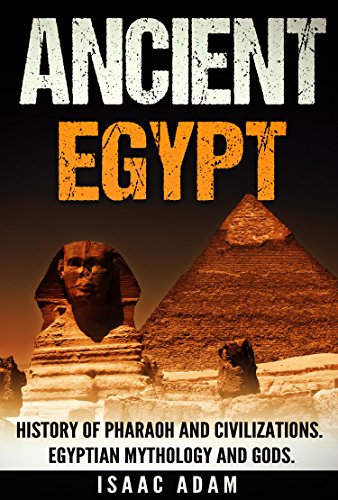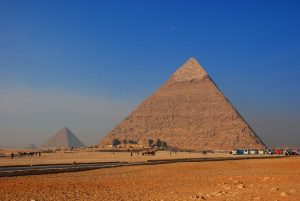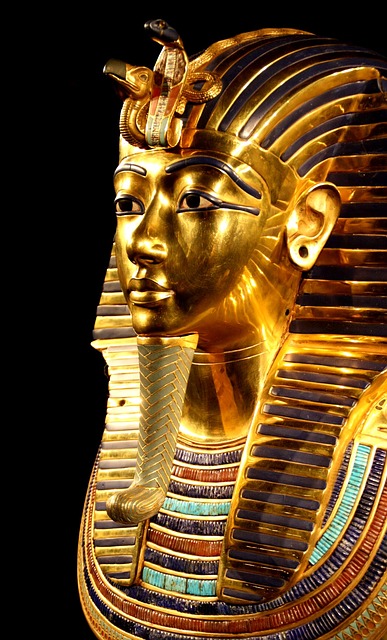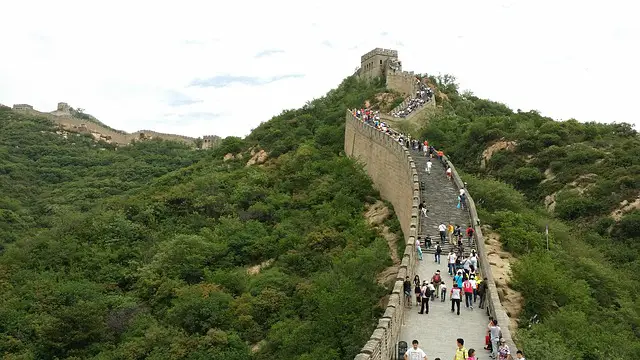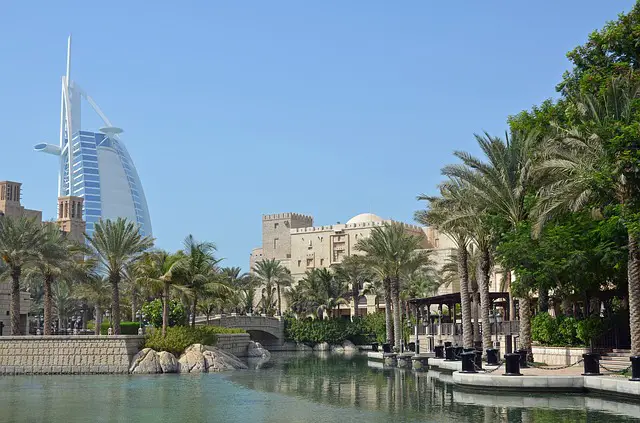During the ancient times, the Egyptians used to build many monuments. These famous ancient Egyptian pyramids and the three largest included temples and pyramids. Pyramids were basically built for religious reasons. The Pyramids were grand tombs of pharaohs. After death, the pharaohs were buried in them. Before pyramids were built, their bodies were buried in bench-like structures called mastabas. Read about Famous ancient Egyptian pyramids and the three largest
Famous ancient Egyptian pyramids and the three largest during the reign of Khufu.
During the reign of Khufu, at Giza, three pyramids were built along with many smaller pyramids which were constructed in the Nile Valley. The tallest Pyramid among all is about 500 feet, reaches into the sky and covers an area more than 13 acres. A 65 feet tall structure known as The Great Sphinx was built nearby the pyramids to watch over them. It consists of the body of a lion with a human head on top. Most of the people believe that the Sphinx represented King Chefren, who was buried in the middle Pyramid. We learn about Famous ancient Egyptian pyramids and the three largest in history. Egyptian pyramids facts and the great pyramid of giza.
Ancient Egypt: History of Pharaoh and Civilizations. Egyptian mythology and gods. By Isaac Adam
The hidden secrets of the Famous ancient Egyptian pyramids and the three largest
An architect named Imhotep was the first who came up with the idea of stacking mastabas on top of each other and creating a building composed of a number of steps that gradually decreased in size towards the head. It was built and named as the Step Pyramid of Djoser. According to the people, this pyramids represented a huge stairway that led the soul of the dead pharaoh towards the heavens. The dark part of the sky where the stars revolve was considered by the Egyptians as the physical gateway towards the heavens. Famous ancient Egyptian pyramids and the three largest are mystical.
A few Egyptian pharaohs who wanted the famous ancient Egyptian pyramids and the three largest
One of the narrow passages extending from the main burial chamber through the entire structure of the Pyramid points towards the center of this dark part of the sky. This proves that the pyramid was designed so that the deceased pharaoh’s soul would reach into the house of the gods. There were often a few Egyptian pharaohs who wanted to take their most valuable possessions along with them in death, so that they could enjoy these things in their next life. So according to their wish, silver, gold, and bronze artifacts were put inside the great tombs and their chambers were adorned with fine linens and artworks. Some pyramids also had a rest room built for the pharaoh.
These travel accessories will certainly help out.
In the earliest dynasties, the Egyptians constructed pyramids completely with stone. What are pyramids?
In the earliest dynasties, the Egyptians constructed pyramids completely with stone. Limestone was the material used for the main body of the pyramids. However, a higher quality of limestone was used for making the outer casing. The gate of the pyramid and the roofs and walls of the burial chamber were constructed using granite. Granite was occasionally used in constructing the outer casing. The workers used to cut softer stones like limestone with the help of chisels, drills, and saws made of copper. On the other hand, granite, syenite, basalt, and other hard stones were cut with time-consuming methods like drilling and pounding with dolerite as copper tools were not effective. Blocks were moved from one place to another on a sledge and it was most likely made slippery by water.
The tomb of Djehutihotep among Famous ancient Egyptian pyramids and the three largest
The early pyramid builders faced major problems while moving huge quantities of stone. The drawings on the tomb of Djehutihotep from the 12th dynasty shows 172 men pulling a huge statue that weighed 60 tons on a sledge. A few Egyptologists assumed that 45 workers would be needed to move a lubricated block of 16,300 kg. Others thought that the workers used cradle-like machines made of stones. If four of these machines could be fitted around the four corners of a block, then it could be rolled easily from one place to another. However, no one knows whether the Egyptian workers used this method or not.
Why were the pyramids really built and pyramids in ancient Egypt.
Since stones were roughly cut and then used to form the core of the pyramids, the workers faced another problem on deciding which material to use in order to fill the gaps. Huge amount of gypsum and rubble were needed to stabilize the construction. Large quantities of wood were needed to heat it, in order to make the gypsum mortar. Egyptologists assume that to build the pyramids of Giza and other earlier pyramids, Egypt had to clear its forest and scrap out every bit of wood it had. They also suggested that the Egyptians might have collected it from recycling old wood and other earlier materials.
The Famous ancient Egyptian pyramids and the three largest tombs were protected from looters.
The tombs were protected from looters. They carefully hid the entrance to the inner chambers. The pharaoh’s mummy was kept in a coffin called a sarcophagus. It was made of the hardest stone blocks. Egyptians believed that anyone who disturbed or entered a pharaoh’s burial place would be cursed forever. But the belief did not stop the tombs from being looted by robbers. However, the pyramids were very stable. Even though their outer limestone layers were blown to dust, the structures still remain standing. The Great Pyramid is now one of the Seven Wonders of the World.
Mummification was preserving the body in a life-like way possible
The ancient Egyptians had a religious belief that the physical body would be important in the next life. For this reason they mummified the dead ones. The goal of mummification was preserving the body in a lifelike way possible. The Egyptians believed that the preserved body was the home for their soul and that if the body was destroyed or harmed, the spirit might be lost.
During the early years, the burials were just holes dug in the sand where the body was placed in a curled-up position. The heat and dryness of the sand helped to dehydrate these bodies rapidly, creating natural mummies. The body was surrounded by jars and baskets that contained food and drink. A few other objects such as tools were also included. This was done so that the person could use them in the afterlife. The ancient Egyptians began to bury their dead in coffins, but the bodies were not exposed to heat and dryness. This lack of heat and dryness caused the bodies to decay. Thus, the Egyptians changed their burial process.
The first step was the removal of all internal parts
The ancient Egyptians later developed new methods for drying and preparing the bodies so that they would not decay and named this process as mummification. This process took around seventy days. Special people were appointed as embalmers and their job was to wrap the body. The priests had to know the correct rituals, and they also needed complete knowledge regarding human anatomy.
The first step was the removal of all internal parts of the dead body that might decay quickly. Removing the internal parts was a delicate operation which could easily disfigure the face or the body. The embalmers had to remove the brain, the organs of the abdomen and chest too. They only left the heart where it was, because they believed it to be the core of a person’s intelligence. The other organs including the stomach, lungs, and intestines were preserved separately in special jars. These jars were buried along with the mummy in the coffin. As years passed, the processes changed a bit. Later the organs were wrapped, and replaced within the body of the mummies. However, unused jars were still a part of the burial process.
Remove all moisture from the dead body from Famous ancient Egyptian pyramids and the three largest ones
The next task of the embalmers was to remove all moisture from the dead body. This was done by covering the body with a type of salt called natron that had immense drying properties. Additional natron packets were also placed inside the body of the mummies. As soon as the body had dried out fully, they removed the packets from the inside and washed the natron off the body lightly. The body acquired a dried-out recognizable human form from this.
The next step was the wrapping of the body. For each mummy hundreds yards of linen was required. The priests would carefully wound the strips of linen around the body. Sometimes they even wrapped each finger and toe separately. Amulets were placed on the linen for the protection of the dead from any mishap. Magical words were often written on some strips of linen. Finally, the priests covered the body with the final cloth and secured it. After that, the mummy was finally complete.
Burial process of a pharaoh
During burial process of a pharaoh, the priests are not the only ones who buried the body. There are others who perform other works related to the burial process. The tomb preparation usually began before the person’s death. Since there was a deadline, the workers, craftsmen, and artists had to work very swiftly. There were a lot of things to be placed inside the tomb so that a person could use it in the Afterlife. These included furniture and statuettes, wall paintings of religious or civil life, jewelry, cosmetics and lists of food and prayers. After preparing the tomb and everything, then burial ceremony would start.
The most significant part of the ceremony was the Opening of the Mouth
At the beginning of the funeral, at the tomb’s entrance a few special religious rites were performed by the priests. The most significant part of the ceremony was the Opening of the Mouth. In this moment a priest touched various parts of the mummy with a specific instrument to unfold those parts to the senses needed in the Afterlife and that was enjoyed in the earthly life. When he touches the instrument to the mouth, it is said that the dead person could now eat and speak. After all the rituals the mummy was considered to be ready for his journey to the Afterlife. After placing the mummy in his coffin, it was kept in the burial chamber and the entrance was sealed up.
Cemetery at Sakkara of Famous ancient Egyptian pyramids and the three largest
It is only the pharaohs of Egypt who were mummified after their deaths and buried in grand tombs. Sometimes members of the nobility and administrative system also received the same treatment. It was rare for the common people to be treated in that way. However, the process was expensive. Some animals were also mummified for various religious reasons. From the early dynasties, the sacred bulls even had their own cemetery at Sakkara. Other animals like baboons, birds, cats, and crocodiles also had great religious importance. They were sometimes mummified too, especially in the dynasties afterwards.
Most people who obtained knowledge about the Egyptians and their elaborate burial practices might suggest that they were obsessed with the thoughts of death. The only reason they began to make plans for their death early was because of their immense love of life. The Egyptians thought that no life was better than the present, and all they wanted was to be sure that this beautiful life would still continue after death.
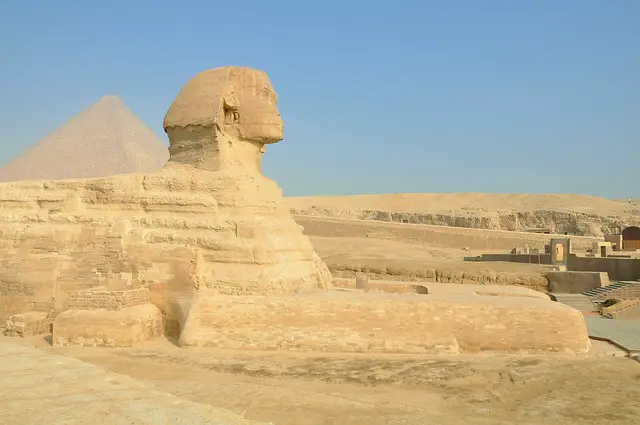
Famous ancient Egyptian pyramids and the three largest had the best preserved mummies.
Across most of early Egyptian history, mummification was practiced. At the very beginning the mummies from prehistoric times were probably accidental. Egyptians probably began to mummify the dead from about 2600 B.C., during the Fourth and Fifth Dynasties. For over 2,000 years this practice developed and even reached the Roman Period. The quality of the mummies varied from one period to another. The Eighteenth till the Twentieth Dynasties of the New Kingdom had the best preserved and prepared mummies. King Tutankhamen and other well-known pharaohs are believed to be among those. Why were the pyramids really built and pyramids in ancient Egypt.
Famous ancient Egyptian pyramids and the three largest
Extract From:
Ancient Egypt: History of Pharaoh and Civilizations. Egyptian mythology and gods. By Isaac Adam
Available from Amazon
You will require some awesome, well recommended luggage. Check out…
Some great luggage and travel aids to add to your comfort.
Check out some of these other awesome links..
- Harare Hotels under $150. One and two star accommodation.
- Ho Chi Minh Hotels under $15. One and Two star quality accommodation.
- Hong Kong hotels under $40. One and Two star accommodation
- Top 10 Best Men’s Gifted and Complimented PerfumesA new fragrance for men inspired by the spirit of the open ...
- Top 10 Best Perfume Gifts for Men at Low-costThis timeless collection of modern fragrances offers exceptional quality at affordable prices ...
- Top 10 Best Inexpensive Perfumes for Men as a GiftAn optimistic scent for a liberated soul, HUGO Man is presented in ...


